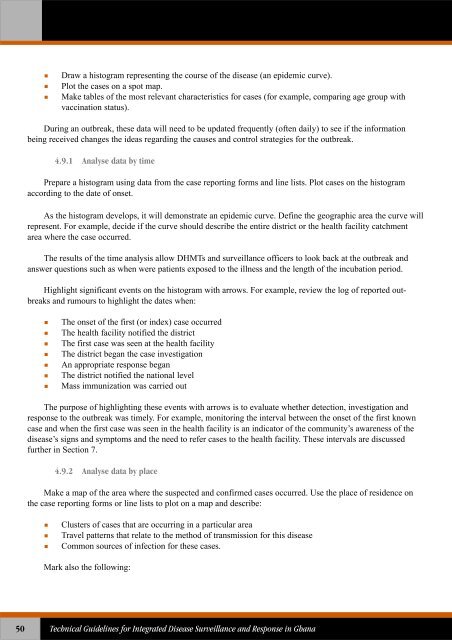Technical Guidelines for Integrated Disease Surveillance ... - PHRplus
Technical Guidelines for Integrated Disease Surveillance ... - PHRplus
Technical Guidelines for Integrated Disease Surveillance ... - PHRplus
You also want an ePaper? Increase the reach of your titles
YUMPU automatically turns print PDFs into web optimized ePapers that Google loves.
Draw a histogram representing the course of the disease (an epidemic curve).Plot the cases on a spot map.Make tables of the most relevant characteristics <strong>for</strong> cases (<strong>for</strong> example, comparing age group withvaccination status).During an outbreak, these data will need to be updated frequently (often daily) to see if the in<strong>for</strong>mationbeing received changes the ideas regarding the causes and control strategies <strong>for</strong> the outbreak.4.9.1 Analyse data by timePrepare a histogram using data from the case reporting <strong>for</strong>ms and line lists. Plot cases on the histogramaccording to the date of onset.As the histogram develops, it will demonstrate an epidemic curve. Define the geographic area the curve willrepresent. For example, decide if the curve should describe the entire district or the health facility catchmentarea where the case occurred.The results of the time analysis allow DHMTs and surveillance officers to look back at the outbreak andanswer questions such as when were patients exposed to the illness and the length of the incubation period.Highlight significant events on the histogram with arrows. For example, review the log of reported outbreaksand rumours to highlight the dates when:The onset of the first (or index) case occurredThe health facility notified the districtThe first case was seen at the health facilityThe district began the case investigationAn appropriate response beganThe district notified the national levelMass immunization was carried outThe purpose of highlighting these events with arrows is to evaluate whether detection, investigation andresponse to the outbreak was timely. For example, monitoring the interval between the onset of the first knowncase and when the first case was seen in the health facility is an indicator of the community’s awareness of thedisease’s signs and symptoms and the need to refer cases to the health facility. These intervals are discussedfurther in Section 7.4.9.2 Analyse data by placeMake a map of the area where the suspected and confirmed cases occurred. Use the place of residence onthe case reporting <strong>for</strong>ms or line lists to plot on a map and describe:Clusters of cases that are occurring in a particular areaTravel patterns that relate to the method of transmission <strong>for</strong> this diseaseCommon sources of infection <strong>for</strong> these cases.Mark also the following:50<strong>Technical</strong> <strong>Guidelines</strong> <strong>for</strong> <strong>Integrated</strong> <strong>Disease</strong> <strong>Surveillance</strong> and Response in Ghana















